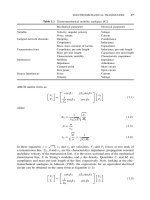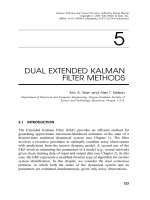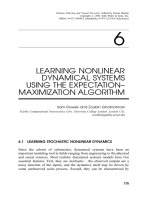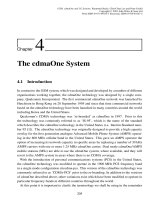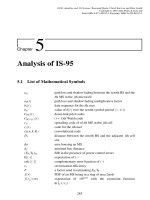Tài liệu RF MEMS and Their Applicatio P1 pdf
Bạn đang xem bản rút gọn của tài liệu. Xem và tải ngay bản đầy đủ của tài liệu tại đây (1.18 MB, 30 trang )
RF MEMS
and Their Applications
RF MEMS
and Their Applications
Vijay K. Varadan
K.J. Vinoy
K.A. Jose
Pennsylvania State University, USA
Copyright
2003 John Wiley & Sons Ltd, The Atrium, Southern Gate, Chichester,
West Sussex PO19 8SQ, England
Telephone (+44) 1243 779777
Email (for orders and customer service enquiries):
Visit our Home Page on www.wileyeurope.com or www.wiley.com
Reprinted April 2003
All Rights Reserved. No part of this publication may be reproduced, stored in a retrieval system or
transmitted in any form or by any means, electronic, mechanical, photocopying, recording, scanning or
otherwise, except under the terms of the Copyright, Designs and Patents Act 1988 or under the terms of
a licence issued by the Copyright Licensing Agency Ltd, 90 Tottenham Court Road, London W1T 4LP,
UK, without the permission in writing of the Publisher. Requests to the Publisher should be addressed
to the Permissions Department, John Wiley & Sons Ltd, The Atrium, Southern Gate, Chichester, West
Sussex PO19 8SQ, England, or emailed to , or faxed to (+44) 1243 770620.
This publication is designed to provide accurate and authoritative information in regard to the subject
matter covered. It is sold on the understanding that the Publisher is not engaged in rendering
professional services. If professional advice or other expert assistance is required, the services of a
competent professional should be sought.
Other Wiley Editorial Offices
John Wiley & Sons Inc., 111 River Street, Hoboken, NJ 07030, USA
Jossey-Bass, 989 Market Street, San Francisco, CA 94103-1741, USA
Wiley-VCH Verlag GmbH, Boschstr. 12, D-69469 Weinheim, Germany
John Wiley & Sons Australia Ltd, 33 Park Road, Milton, Queensland 4064, Australia
John Wiley & Sons (Asia) Pte Ltd, 2 Clementi Loop #02-01, Jin Xing Distripark, Singapore 129809
John Wiley & Sons Canada Ltd, 22 Worcester Road, Etobicoke, Ontario, Canada M9W 1L1
Wiley also publishes its books in a variety of electronic formats. Some content that appears
in print may not be available in electronic books.
Library of Congress Cataloging-in-Publication Data
Varadan, V.K., 1943 –
RF MEMS and their applications / Vijay K. Varadan, K.J. Vinoy, and K.A. Jose.
Includes bibliographical references and index.
ISBN 0-470-84308-X (alk. paper)
1. Radio circuits–Equipment and supplies. 2. Microelectromechanical systems. 3. Microwave
circuits. I. Vinoy, K.J. (Kalarickaparambil Joseph), 1969– II. Jose K. Abraham. III. Title.
TK6560.V33 2002
621.384
13–dc21 2002071393
British Library Cataloguing in Publication Data
A catalogue record for this book is available from the British Library
ISBN 0-470-84308-X
Typeset in 10/12pt Times by Laserwords Private Limited, Chennai, India
Printed and bound in Great Britain by Biddles Ltd, Guildford and King’s Lynn
This book is printed on acid-free paper responsibly manufactured from sustainable forestry
in which at least two trees are planted for each one used for paper production.
Contents
Preface xi
1 Microelectromechanical systems (MEMS) and radio frequency
MEMS 1
1.1 Introduction 1
1.2 MEMS 2
1.3 Microfabrications for MEMS 5
1.3.1 Bulk micromachining of silicon 5
1.3.2 Surface micromachining of silicon 8
1.3.3 Wafer bonding for MEMS 9
1.3.4 LIGA process 11
1.3.5 Micromachining of polymeric MEMS devices 13
1.3.6 Three-dimensional microfabrications 15
1.4 Electromechanical transducers 16
1.4.1 Piezoelectric transducers 18
1.4.2 Electrostrictive transducers 20
1.4.3 Magnetostrictive transducers 22
1.4.4 Electrostatic actuators 24
1.4.5 Electromagnetic transducers 27
1.4.6 Electrodynamic transducers 29
1.4.7 Electrothermal actuators 32
1.4.8 Comparison of electromechanical actuation schemes 34
1.5 Microsensing for MEMS 35
1.5.1 Piezoresistive sensing 35
1.5.2 Capacitive sensing 37
1.5.3 Piezoelectric sensing 37
1.5.4 Resonant sensing 38
1.5.5 Surface acoustic wave sensors 38
1.6 Materials for MEMS 42
1.6.1 Metal and metal alloys for MEMS 42
1.6.2 Polymers for MEMS 42
1.6.3 Other materials for MEMS 44
1.7 Scope of this book 44
References 45
vi
CONTENTS
2 MEMS materials and fabrication techniques 51
2.1 Metals 51
2.1.1 Evaporation 51
2.1.2 Sputtering 53
2.2 Semiconductors 54
2.2.1 Electrical and chemical properties 54
2.2.2 Growth and deposition 57
2.3 Thin films for MEMS and their deposition techniques 61
2.3.1 Oxide film formation by thermal oxidation 61
2.3.2 Deposition of silicon dioxide and silicon nitride 62
2.3.3 Polysilicon film deposition 64
2.3.4 Ferroelectric thin films 64
2.4 Materials for polymer MEMS 67
2.4.1 Classification of polymers 67
2.4.2 UV radiation curing 74
2.4.3 SU-8 for polymer MEMS 80
2.5 Bulk micromachining for silicon-based MEMS 84
2.5.1 Isotropic and orientation-dependent wet etching 84
2.5.2 Dry etching 88
2.5.3 Buried oxide process 88
2.5.4 Silicon fusion bonding 89
2.5.5 Anodic bonding 90
2.6 Silicon surface micromachining 91
2.6.1 Sacrificial layer technology 91
2.6.2 Material systems in sacrificial layer technology 92
2.6.3 Surface micromachining using plasma etching 93
2.6.4 Combined integrated-circuit technology
and anisotropic wet etching 94
2.7 Microstereolithography for polymer MEMS 94
2.7.1 Scanning method 95
2.7.2 Two-photon microstereolithography 96
2.7.3 Surface micromachining of polymer MEMS 97
2.7.4 Projection method 97
2.7.5 Polymeric MEMS architecture with silicon, metal
and ceramics 102
2.7.6 Microstereolithography integrated with thick-film
lithography 105
2.8 Conclusions 105
References 105
3 RF MEMS switches and micro relays 109
3.1 Introduction 109
3.2 Switch parameters 111
3.3 Basics of switching 115
3.3.1 Mechanical switches 116
3.3.2 Electronic switches 117
CONTENTS
vii
3.4 Switches for RF and microwave applications 117
3.4.1 Mechanical RF switches 118
3.4.2 PIN diode RF switches 119
3.4.3 Metal oxide semiconductor field effect transistors
and monolithic microwave integrated circuits 123
3.4.4 RF MEMS switches 124
3.4.5 Integration and biasing issues for RF switches 125
3.5 Actuation mechanisms for MEMS devices 127
3.5.1 Electrostatic switching 128
3.5.2 Approaches for low-actuation-voltage switches 141
3.5.3 Mercury contact switches 146
3.5.4 Magnetic switching 148
3.5.5 Electromagnetic switching 148
3.5.6 Thermal switching 151
3.6 Bistable micro relays and microactuators 152
3.6.1 Magnetic actuation in micro relays 152
3.6.2 Relay contact force and materials 156
3.7 Dynamics of the switch operation 157
3.7.1 Switching time and dynamic response 158
3.7.2 Threshold voltage 160
3.8 MEMS switch design, modeling and evaluation 162
3.8.1 Electromechanical finite element analysis 163
3.8.2 RF design 165
3.9 MEMS switch design considerations 174
3.10 Conclusions 175
References 178
4 MEMS inductors and capacitors 183
4.1 Introduction 183
4.2 MEMS/micromachined passive elements: pros and cons 184
4.3 MEMS inductors 184
4.3.1 Self-inductance and mutual inductance 185
4.3.2 Micromachined inductors 188
4.3.3 Effect of inductor layout 194
4.3.4 Reduction of stray capacitance of planar
inductors 198
4.3.5 Approaches for improving the quality factor 200
4.3.6 Folded inductors 211
4.3.7 Modeling and design issues of planar inductors 212
4.3.8 Variable inductors 215
4.3.9 Polymer-based inductors 215
4.4 MEMS capacitors 215
4.4.1 MEMS gap-tuning capacitors 217
4.4.2 MEMS area-tuning capacitors 224
4.4.3 Dielectric tunable capacitors 228
4.5 Conclusions 229
References 235
viii
CONTENTS
5 Micromachined RF filters 241
5.1 Introduction 241
5.2 Modeling of mechanical filters 244
5.2.1 Modeling of resonators 244
5.2.2 Mechanical coupling components 251
5.2.3 General considerations for mechanical filters 257
5.3 Micromechanical filters 258
5.3.1 Electrostatic comb drive 258
5.3.2 Micromechanical filters using comb drives 260
5.3.3 Micromechanical filters using electrostatic coupled
beam structures 265
5.4 Surface acoustic wave filters 268
5.4.1 Basics of surface acoustic wave filter operation 269
5.4.2 Wave propagation in piezoelectric substrates 270
5.4.3 Design of interdigital transducers 271
5.4.4 Single-phase unidirectional transducers 274
5.4.5 Surface acoustic wave devices: capabilities, limitations
and applications 275
5.5 Bulk acoustic wave filters 276
5.6 Micromachined filters for millimeter wave frequencies 278
5.7 Summary 282
References 283
6 Micromachined phase shifters 285
6.1 Introduction 285
6.2 Types of phase shifters and their limitations 286
6.2.1 Ferrite phase shifters 287
6.2.2 Semiconductor phase shifters 287
6.2.3 Ferroelectric thin-film phase shifters 288
6.2.4 Limitations of phase shifters 288
6.3 MEMS phase shifters 289
6.3.1 Switched delay line phase shifters 289
6.3.2 Distributed MEMS phase shifters 289
6.3.3 Polymer-based phase shifters 296
6.4 Ferroelectric phase shifters 298
6.4.1 Distributed parallel plate capacitors 299
6.4.2 Bilateral interdigital phase shifters 301
6.4.3 Interdigital capacitor phase shifters 304
6.5 Applications 305
6.6 Conclusions 305
References 306
7 Micromachined transmission lines and components 309
7.1 Introduction 309
7.2 Micromachined transmission lines 310
7.2.1 Losses in transmission lines 311
7.2.2 Co-planar transmission lines 313
CONTENTS
ix
7.2.3 Microshield and membrane-supported
transmission lines 316
7.2.4 Microshield circuit components 321
7.2.5 Micromachined waveguide components 324
7.2.6 Micromachined directional couplers 327
7.2.7 Micromachined mixer 327
7.2.8 Passive components: resonators and filters 330
7.2.9 Micromachined antennae 332
7.3 Design, fabrication and measurement 334
7.3.1 Design 335
7.3.2 Fabrication 335
7.3.3 Evaluation 335
7.4 Conclusions 337
References 338
8 Micromachined antennae 343
8.1 Introduction 343
8.2 Overview of microstrip antennae 344
8.2.1 Basic characteristics of microstripeantennae 344
8.2.2 Design parameters of microstrip antennae 347
8.3 Micromachining techniques to improve antenna performance 351
8.4 Micromachining as a fabrication process for small antennae 356
8.5 Micromachined reconfigurable antennae 360
8.6 Summary 362
References 363
9 Integration and packaging for RF MEMS devices 365
9.1 Introduction 365
9.2 Role of MEMS packages 366
9.2.1 Mechanical support 366
9.2.2 Electrical interface 367
9.2.3 Protection from the environment 367
9.2.4 Thermal considerations 367
9.3 Types of MEMS packages 367
9.3.1 Metal packages 368
9.3.2 Ceramic packages 368
9.3.3 Plastic packages 368
9.3.4 Multilayer packages 369
9.3.5 Embedded overlay 369
9.3.6 Wafer-level packaging 370
9.3.7 Microshielding and self-packaging 372
9.4 Flip-chip assembly 373
9.5 Multichip module packaging 375
9.5.1 Wafer bonding 377
9.6 RF MEMS packaging: reliability issues 380
9.6.1 Packaging materials 380
9.6.2 Integration of MEMS devices with microelectronics 380
x
CONTENTS
9.6.3 Wiring and interconnections 382
9.6.4 Reliability and key failure mechanisms 382
9.7 Thermal issues 383
9.8 Conclusions 383
References 384
Index 387


